

Adolescent and young adult (AYA) cancer survivors have significant psychosocial needs, and oncology navigators are in a unique position to address those needs with both skill and sensitivity.
Below, Megan Solinger, MHS, MA, OPN-CG, and Paula Sanborn, MS, APRN, FNP-C, CPHON, ONN-CG, discuss the psychosocial challenges faced by younger patients with cancer and what navigators can do to support them.
“The disruptive nature of a cancer diagnosis for a young patient is huge,” said Ms Solinger, director, Service & Care Delivery, at the Ulman Foundation in Baltimore, MD. “Our job as navigators is to remove as many of these disruptions as we can.”
Who Are AYAs?
By definition, AYAs fall between the ages of 15 and 39 years. “But there’s a lot of variation as to where and who these people are across that time line,” she said.
The incidence of cancer among AYAs is rising—about 89,000 new diagnoses a year—but so are cancer survival rates. According to Ms Solinger, because these patients are living longer after a cancer diagnosis, many have the potential for a long and full life ahead of them. This underlines the full spectrum of needs in the AYA population: it’s not just about the cancer diagnosis and treatment, but also the psychosocial, physical, emotional/mental, financial, and long-term impacts of cancer and its treatment.
“We have a real opportunity to better support these patients if we can understand the specifics about them and their particular challenges—those that may be different from patients on the pediatric or geriatric side,” she said. “Understanding this population is key to better supporting them through the cancer continuum.”
AYAs are in a period of growth, change, and instability and are experiencing pivotal life events at a number of different stages. Whether they have their first boyfriend or girlfriend, they’re starting college, embarking on their career, traveling the world, or starting a family, a cancer diagnosis can shatter these plans. The implications vary widely depending on the person—one might fear the loss of their independence, whereas another might worry about fertility. But whether they’re 18, 25, or 35, the implications of a cancer diagnosis are significant and unique to each individual patient, and they may ebb and flow throughout treatment, or even day-to-day.
Patients in this age range can also find themselves in a no-man’s-land when it comes to care, not feeling like they really belong in children’s or adult patient hospitals and facilities. This can be incredibly isolating for patients, and the navigator is crucial to helping them feel supported and getting them the resources that they need, regardless of where treatment takes place.
The Importance of Peer Support
Social isolation is one of the biggest challenges faced by younger patients with cancer. They may not know anyone else with cancer and may feel like no one understands what they are going through. Losing their forward momentum with their education, career, dating, and friendships—while everyone else around them is moving on—can make them feel incredibly alone.
“These patients are watching their friends going off to college, dating, traveling, doing all these wonderful things,” she said. “But if you’re diagnosed with cancer, you’re not doing those things; you’re tethered to your appointments, and you have to be really careful about what you do, who you see, and where you go.”
According to Ms Sanborn, a sarcoma nurse practitioner at Nationwide Children’s Hospital in Columbus, OH, navigators can make a huge impact by connecting their patients with other AYA survivors who understand what they’re going through. Talking to a peer about treatment, self-esteem, relationships, and body image issues is invaluable to these patients.
“I led AYA support groups for 5 years, and a lot of the time, they weren’t even talking about cancer; they were talking about life as a 20- or 23-year-old,” she recalled. “One of the patients had recurrent metastatic disease and was literally dying from her cancer, but the support that I saw the others give her—you can’t replace that with anything else that you do for them.”
She noted that AYAs can often struggle in their relationships, but the patient might not be the only one struggling. “Hearing that your boyfriend has cancer is a lot for an 18-year-old to take on,” she said.
Physical changes due to cancer and treatment can be traumatizing; these patients can experience weight gain, hair loss, or even amputation, but support groups/meetups, mental health resources (including emotional support animals), and caregiver/family/community support can help to mitigate some of those feelings of isolation and help them to feel more “normal.”
If patients are in school, some might want to take a break during treatment, while others might prefer accommodations that let them complete treatment and classes at the same time. This all comes down to the individual patient and again underlines the importance of individualized care.
“One of my patients with Ewing sarcoma would come in every morning and get her chemotherapy, backpack her fluids and mesna, and then walk the campus at Ohio State University, and she never missed a day of class,” said Ms Sanborn. “We just had to make that happen for her. She was an exceptionally smart kid.”
Other AYA-Specific Barriers
Fertility preservation is another huge barrier, as AYAs have the added stress of considering how their cancer treatments may impact their fertility. According to Ms Solinger, fertility preservation is something that must be addressed with every single AYA patient, regardless of whether they have ever thought about having children or they already have children. Sexual health conversations are also important to people in this age-group and should be brought up to patients.
The financial implications of cancer can be particularly daunting for young adult patients, as many lack savings and/or sufficient health insurance plans (or are uninsured). In addition to financial assistance, addressing basic needs like transportation, housing, and assistance with relocation (if necessary) is a crucial component of the navigator’s role.
Survivorship is also unique for AYA patients, as young adult cancer survivors live with the aftermath of cancer and its treatment for much longer than many other patients. These years of survivorship can bring on medical complications as well as psychosocial challenges.
“A lot of these patients get a treatment plan and then kind of go into autopilot,” she said. “Then suddenly they’re done with treatment, and they’re just supposed to go back out and resume life; that’s when people tend to struggle.”
According to Ms Solinger, guiding patients through the different phases of treatment, especially into survivorship, can make those transitions easier and help them ease back into life after cancer treatment. Finally, making sure AYA patients have access to appropriate mental health resources is vital to their well-being throughout the cancer continuum.
“Our job as navigators is to think about all the resources that a patient may be lacking,” she said. “What’s going to help get them up and going, stay healthy, show up for their appointments, and really fight this fight?”
Providing Informed Care
When caring for AYAs, providers should be cognizant of age-appropriate communication, as well as the patient’s preferred mode of communication (eg, e-mail, printouts, online charts) and health literacy levels. They should also acknowledge and understand the level of parent/family involvement the patient desires in conversations about their care (keeping in mind that this will be different for minors compared with 18-year-olds).
“This is a big part of creating trust with your patients, and that’s ultimately what you want to do,” she noted.
Going through cancer treatment is incredibly hard, no matter a person’s age. Some people have to quit their jobs, some feel too sick to continue doing the things they love, and others simply lose sight of the things they enjoyed before their diagnosis. But finding a passion, a hobby, or something to look forward to—even if it’s just a 10-minute walk every day—can give someone a reason to get out of bed in the morning.
“We should help figure out what these patients can do to give them even a little bit of purpose,” said Ms Solinger. “I’m not talking about something grandiose like starting a nonprofit, just something they can look forward to, they can control, and they can physically do, and hopefully they can find some joy in it.”



